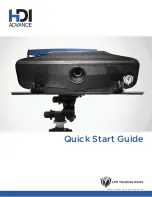
Banner AG4 Series Safety Laser Scanner
4.5.3
Minimum Separation Distance (European Standards)
When all factors that influence the Separation Distance are considered, the formula is:
S = (K x T) + C + Z
sm
+ Z
refl
S
= the minimum distance between the hazard and the protective field.
S
is never less than 100 mm (4 in.).
K
= approach speed (see note 1 below)
2000 mm per second
(79 inches per second) for S < 500mm (20 in.)
1600 mm per second
(63 inches per second) for S > 500mm (20 in.)
T
= overall system stopping performance in seconds (see note 2 below)
C
= an additional distance in millimeters (inches), based on intrusion towards the hazard prior to
actuation of the Scanner. This value is never less than zero.
Z
sm
= the additional distance needed to account for distance measurement error.
Z
refl
= the additional distance needed to account for error due to reflections from retro reflective
surfaces.
Notes
The above formula is derived from ISO 13855 (2002).
1. If
S
is greater than 500mm then
K
= 1600 mm/sec can be used instead of the 2000 mm/sec speed, however, if the 1600 mm/sec value is
used then
S
can never be less than 500mm.
2.
T
is the time from the actuation of the sensing function to the machine assuming a safe condition, comprising a minimum of two phases:
T = t1 + t2
Where:
t1
is the maximum time between the actuation of the sensing function and the output signal switching devices
(OSSDs) being in the off state. This is the response time of the Scanner.
Consideration for Adjacent Scanners.
When adjacent Scanner share the same detection plane and have an unobstructed view of each other, an additional
40 ms time must be added to the response times of both scanners. If the adjacent scanners’ detection planes are shielded so
that there is no clear line of sight between sensors or there is at least a 100 mm (4”) detection plane offset, then the
40 ms addition is not required.
t2
is the maximum response time of the machine, i.e. the time required to stop the machine or remove the risks
after receiving the output signal from the protective equipment.
t2
is influenced by various factors, e.g.
temperature, switching time of valves, and ageing of components.
t2
is usually measured by a stop-time
measuring device.
If the machine manufacturer’s specified stop time is used, add at least 20% to allow
for possible clutch/ brake system deterioration.
This measurement must take into account the slower of the
two MPCE channels, and the response time of all devices or controls that react to stop the machine (e.g.,
UM-FA-9A
safety module). See Notice Regarding MPCEs.
If all devices are not included, the calculated
separation distance (Ds) will be too short and serious injury could result.
32
P/N 144924 05/2009
Product Manual
















































